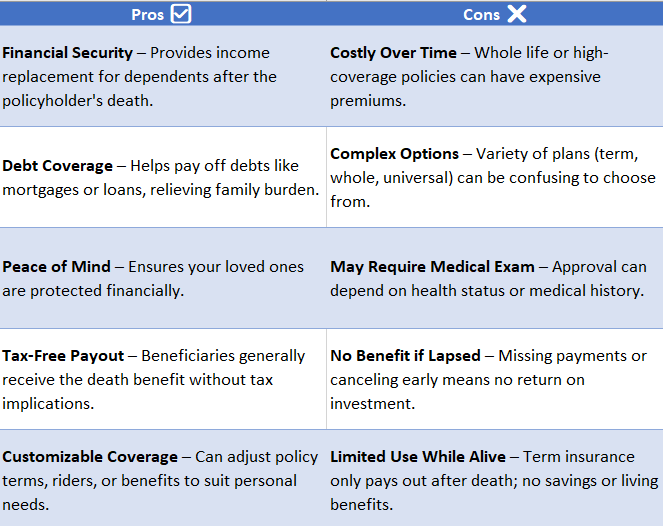Term vs. Permanent Life Insurance: Key Differences
Understanding the Basics: What Sets Term and Permanent Life Insurance Apart?
Choosing the right life insurance can be daunting, but understanding the difference between term and permanent life insurance simplifies the decision. These two types cater to different needs, providing peace of mind for you and your loved ones.
Term Life Insurance: Simplicity and Affordability
- Coverage Duration: Like renting, term life insurance covers you for a specific period, such as 10, 20, or 30 years.
- Cost: More affordable due to its temporary nature.
- Purpose: Best for temporary needs, like paying off a mortgage or funding education.
Permanent Life Insurance: Lifelong Protection
- Coverage Duration: Similar to owning a home, it offers lifelong coverage if premiums are paid.
- Cost: Higher, but accumulates cash value over time.
- Purpose: Ideal for long-term goals, such as estate planning or leaving a legacy.
Understanding the difference between term and permanent life insurance helps you select the right policy. Whether you need short-term or lifelong coverage, knowing your options ensures financial security for your loved ones.
Why Choose Term Life Insurance? Key Benefits and Considerations
Understanding the difference between term and permanent life insurance is essential when selecting the right coverage for your family. Both offer financial protection but serve different purposes. Term life insurance provides coverage for a set period, typically 10 to 30 years, and is often more affordable than permanent options. If you pass away during this term, your beneficiaries receive a payout.
Benefits of Term Life Insurance include:
- Affordability: Lower cost compared to permanent life insurance, making it budget-friendly.
- Flexibility: Choose a term length that aligns with your financial goals, like paying off a mortgage.
- Simplicity: Easy to understand and manage with clear terms.
Considerations:
- No Cash Value: Unlike permanent policies, term insurance doesn’t build cash value.
- Expiration: Coverage ends when the term does, unless renewed or converted.
- Health Changes: Renewing may be costly if health declines.
In summary, the difference between term and permanent life insurance involves cost, duration, and benefits. Term life insurance suits those needing temporary, affordable coverage. Evaluate your financial goals to decide the best option.
Exploring Permanent Life Insurance: Is It the Right Choice for You?
Understanding the difference between term and permanent life insurance is essential for financial planning. Think of life insurance as a safety net: term insurance is temporary, like renting a house, while permanent insurance is lifelong, akin to owning a home.
What is Permanent Life Insurance?
Permanent life insurance provides lifelong coverage as long as premiums are paid. Unlike term insurance, which ends after a set period, permanent insurance accumulates cash value over time, offering financial flexibility for borrowing or retirement.
Key Differences to Consider
- Duration: Term insurance is temporary; permanent insurance is lifelong.
- Cost: Permanent insurance is typically more expensive due to its extended coverage and cash value.
- Cash Value: Only permanent insurance builds cash value, enhancing financial flexibility.
Choosing between term and permanent life insurance depends on your personal needs and goals. If you seek lifelong coverage with added financial benefits, permanent life insurance might be the right choice for you.
Cost Comparison: How Do Term and Permanent Life Insurance Differ in Price?
Understanding the difference between term and permanent life insurance is crucial when deciding which policy best fits your needs and budget. While both provide financial protection, they vary significantly in cost and coverage duration. Let’s dive into how these differences impact your wallet.
Term Life Insurance: Affordable and Straightforward
- Lower Premiums: Term life insurance is generally more affordable because it offers coverage for a specific period, like 10, 20, or 30 years.
- Temporary Coverage: It’s ideal for those seeking coverage during critical life stages, such as raising children or paying off a mortgage.
Permanent Life Insurance: A Long-Term Investment
- Higher Premiums: Permanent life insurance costs more because it provides lifelong coverage and includes a cash value component.
- Lifetime Protection: This policy is suitable for those who want to ensure financial security for their loved ones no matter when they pass away.
In summary, the difference between term and permanent life insurance boils down to cost and coverage duration. Term insurance is budget-friendly for temporary needs, while permanent insurance is a pricier option that offers lifelong benefits. Choose wisely based on your financial goals and family needs.
Flexibility and Coverage Duration: Which Insurance Type Suits Your Needs?
Understanding the difference between term and permanent life insurance is essential for making informed decisions about your financial future. Each type of insurance offers unique benefits that can align with different life plans.
Term Life Insurance: Simple and Time-Limited
- Coverage Duration: Provides protection for a set period, such as 10, 20, or 30 years.
- Flexibility: Ideal for temporary needs, like covering a mortgage or supporting children until they finish school.
- Affordability: More budget-friendly, making it a popular choice for young families.
Permanent Life Insurance: Lifelong Security
- Coverage Duration: Offers lifetime coverage, provided premiums are maintained.
- Flexibility: Includes a savings component that can grow and be accessed for loans or withdrawals.
- Investment: Although pricier, it provides enduring protection and can serve as a financial asset.
Deciding between term and permanent life insurance should be based on your personal needs and financial goals. Evaluate your current circumstances and future aspirations to determine which insurance type best fits your lifestyle.

Searching for affordable auto insurance? Head over to NewAutoInsurance to compare quotes and save on your policy! Have questions? Call us at 833-211-3817 for immediate assistance!
Investment Opportunities: Does Permanent Life Insurance Offer More Financial Growth?
Life insurance acts as a safety net for families, but choosing between term and permanent life insurance is crucial for your financial future. Understanding the difference between term and permanent life insurance can guide your decision. Term life insurance is like renting a house—affordable and straightforward, covering you for a set period, like 10 or 20 years, and paying out only if you pass away during that time. It ensures your family’s financial security without offering investment growth.
Permanent Life Insurance: A Growing Investment
Permanent life insurance, on the other hand, is akin to owning a home. It provides lifelong coverage and includes a cash value component that grows over time, tax-deferred. This cash value can be used for various financial needs, making it a potential financial asset. You can even borrow against it for emergencies or investments, offering flexibility that term insurance doesn’t provide.
In summary, while term life insurance is a practical choice for simple, affordable coverage, permanent life insurance offers more financial growth opportunities, making it a valuable tool for those looking to invest in their future.
How Does the Difference Between Term and Permanent Life Insurance Affect Your Financial Planning?
Grasping the difference between term and permanent life insurance is vital for making sound financial choices. Think of it like planning a road trip: deciding between a short-term rental or a long-lasting vehicle. Similarly, selecting the right life insurance can shape your financial path.
Term Life Insurance: The Short-Term Solution
- Affordable Premiums: Like renting a car for a weekend, term life insurance is budget-friendly, covering you for a set period, typically 10, 20, or 30 years.
- Simple and Straightforward: You pay premiums during the term, and if something happens to you, your beneficiaries receive the payout.
Permanent Life Insurance: The Long-Term Investment
- Lifetime Coverage: Similar to owning a car, permanent life insurance offers lifelong coverage, provided you continue paying premiums.
- Cash Value Component: It accumulates cash value over time, which can be borrowed against or used for other financial needs.
Deciding between term and permanent life insurance hinges on your financial objectives. By understanding the difference between term and permanent life insurance, you can customize your financial planning to secure peace of mind for you and your family.
Making the Right Choice: Factors to Consider When Choosing Between Term and Permanent Life Insurance
Choosing the right life insurance is crucial for safeguarding your loved ones and financial future. Understanding the difference between term and permanent life insurance can simplify this decision. Term life insurance offers coverage for a set period, such as 10, 20, or 30 years, and is generally more affordable, making it ideal for temporary needs like paying off a mortgage or funding education. In contrast, permanent life insurance provides lifelong coverage, as long as premiums are paid, and accumulates cash value over time, which can be borrowed against or used for retirement. This makes it suitable for long-term financial planning. Ultimately, the choice between term and permanent life insurance depends on your personal needs, financial goals, and budget. By evaluating your current situation and future plans, you can make an informed decision that best protects your family.
How InsuranceShopping Can Help You Navigate the Difference Between Term and Permanent Life Insurance
Understanding the difference between term and permanent life insurance is vital for making smart financial choices. Think of life insurance as a safety net for your loved ones. But which net suits your needs? InsuranceShopping is here to help you understand your options.

Term Life Insurance: The Basics
- Temporary Coverage: Offers protection for a set period, like 10 or 20 years.
- Affordable Premiums: Generally less expensive than permanent life insurance.
- No Cash Value: Does not build cash value over time.
Permanent Life Insurance: The Essentials
- Lifetime Coverage: Provides coverage for your entire life.
- Cash Value Component: Builds cash value that you can borrow against.
- Higher Premiums: Costs more than term insurance but includes additional benefits.
InsuranceShopping makes understanding the difference between term and permanent life insurance easy by offering clear comparisons and expert guidance. Whether you need temporary protection or lifelong security, we help you select the right policy for your needs and budget. Trust us to be your partner in securing your family’s future.
FAQ
-
What is life insurance?
Life insurance is a contract that pays out a sum of money to your beneficiaries after your death. -
What are the main types of life insurance?
The two main types are term life insurance and whole life insurance. -
Who needs life insurance?
Anyone with dependents, debts, or financial responsibilities should consider life insurance. -
How much life insurance do I need?
A common rule is 10–15 times your annual income, but it depends on your personal needs and obligations. -
Can I get life insurance with health issues?
Yes, but premiums may be higher, and acceptance may depend on the severity of your condition.
Explore InsuranceShopping to find a wide range of insurance options tailored to your needs.Take the next step toward affordable coverage. Visit NewAutoInsurance and get instant quotes that fit your budget and driving needs. If you’d like to speak with a representative, call us at 833-211-3817!





